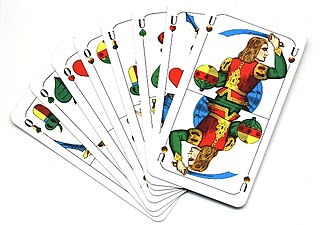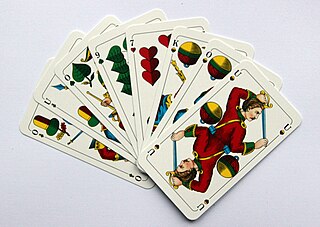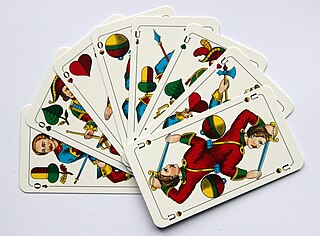
The tarot is a pack of playing cards, used from at least the mid-15th century in various parts of Europe to play card games such as Tarocchini. From their Italian roots, tarot playing cards spread to most of Europe evolving into a family of games that includes German Grosstarok and modern games such as French Tarot and Austrian Königrufen. In the late 18th century, French occultists made elaborate, but unsubstantiated, claims about their history and meaning, leading to the emergence of custom decks for use in divination via tarot card reading and cartomancy. Thus there are two distinct types of tarot pack: those used for card games and those used for divination. However, some older patterns, such as the Tarot de Marseille, originally intended for playing card games, are occasionally used for cartomancy.

Schafkopf, also called Bavarian Schafkopf, is a popular German trick-taking card game of the Ace-Ten family for four players that evolved, towards the end of the 19th century, from German Schafkopf. It is still very popular in Bavaria, where it is their national card game played by around two million people, but it also played elsewhere in Germany and in Austria. It is an official cultural asset and important part of the Old Bavarian and Franconian way of life. Schafkopf is a mentally demanding pastime that is considered "the supreme discipline of Bavarian card games" and "the mother of all trump games."

Johann Kaspar Hechtel was a German businessman, owner of a brass factory in Nuremberg, non-fiction writer and designer of parlour games including the prototype for the Petit Lenormand cartomancy deck. According to published biographies, Hechtel also contributed anonymously to some treatises on physics.

German-suited playing cards are a very common style of traditional playing card used in many parts of Central Europe characterised by 32- or 36-card packs with the suits of Acorns, Leaves, Hearts and Bells. The German suit system is one of the oldest, becoming standard around 1450 and, a few decades later, influencing the design of the now international French suit system of Clubs, Spades, Hearts and Diamonds. Today German-suited playing cards are common in south and east Germany, Austria, German-speaking Switzerland, Liechtenstein, north Italy, Hungary, Czech Republic, Slovakia, Slovenia, Croatia, Bosnia, northern Serbia, southern Poland and central and western Romania.

Bauerntarock also called Brixentaler Bauerntarock or Brixental Tarock, is a point-trick card game played in the Brixental, Austria. It may have originated in the 19th century either as an adaptation of 54-card Tapp Tarock onto the cheaper and smaller 36-card German pack. Another possibility is that it was adapted from the 78-card Grosstarock or Taroc l'Hombre game as the ratio of trumps to non-trumps is almost the same. It uses the Skat Schedule found in popular regional games such as Jass and Schafkopf. It is closely related to Bavarian Tarock, German Tarok, Württemberg Tarock and especially Dobbm. Like Bavarian Tarock and Tapp, Brixental Bauerntarock and Dobbm do not belong to the true tarot games, but have adopted rules from Tapp Tarock. The most fundamental difference between these games and true tarot games is in the use of German or French decks instead of true Tarot playing cards.

German Schafkopf is an old German card game and the forerunner of the popular modern games of Skat, Doppelkopf and Bavarian Schafkopf. Today it is hardly ever played in its original form, but there are a number of regional derivations.

The Unter, formerly Untermann, nicknamed the Wenzel, Wenz or Bauer, and also called the Under, is the court card in German and Swiss-suited playing cards that corresponds to the Jack in French packs. The name Unter is an abbreviation of the former name for these cards, Untermann, which meant something like 'subordinate' or 'vassal'. Van der Linde argues that the King, Ober and Unter in a pack of German cards represented the military ranks of general, officer (Oberofficier) and sergeant (Unterofficier), while the pip cards represented the common soldier.

Acorns is a suit in a deck of German playing cards or Swiss playing cards. This suit was invented in 15th-century German-speaking lands and is a survivor from a large pool of experimental suit signs created to replace the Latin suits. Around 1480, French card makers adapted this sign into clubs in a French deck.

Leaves are one of the four suits in German-suited packs of playing cards. This suit was invented in 15th century Germany and is a survivor from a large pool of experimental suit signs created to replace the Latin suits. Around 1480, French card makers adapted this sign into Spades in the French pack.

Bells are a suit in playing cards of the Swiss-suited and German-suited cards. Unlike the other German suits, this suit was not adapted by French card makers. In its place, there was initially a suit of red crescents until the suit of Diamonds was added to the French pack. The suit is usually known in German as Schellen, but is sometimes abbreviated to Schell. Cards are referred to as in a French deck e.g. the "9 of Bells", but in German as "Schellen 9", or the "Unter of Bells".

Bavarian Tarock or, often, just Tarock, is a card game that was once popular in Bavaria and also played in parts of Austria as well as Berlin. The name is a clue to its origin in the historical German game of [Gross-]Tarock, a game using traditional Tarot cards. At some point in the mid- to late-18th century, attempts were made to emulate Taroc using a standard 36-card German-suited pack, resulting in the formerly popular, south German game of German Tarok. During the last century, the variant played with a pot (Haferl) and often known as Bavarian Tarock or Haferltarock, evolved into "quite a fine game" that, however, has less in common with its Tarock progenitor. German Tarok also generated the very similar game of Tapp, played in Württemberg, and both are related to Bauerntarock, Dobbm and the American games of Frog and Six-Bid Solo. Bavarian Tarock should not be confused with Königrufen, also known as Austrian Tarock or just Tarock.

Dobbm or Tappen is a card game played in the Stubai valley in Austria and is one of a family of games derived from the Tarot game of Grosstarock by adapting its rules to a regular, shortened pack of 36 cards. The ranking and point value of the cards in Dobbm is typical of the family and, like its other members, one player always plays as a soloist against all the others. It is highly popular in the Stubai valley among card players of all generations, but is unknown in the surrounding regions.

Wendish Schafkopf, Wendisch or Wendsch is a card game for four players that uses a Schafkopf pack of German-suited cards or a Skat pack of French playing cards.

Mucken or Muck is a variation of the popular German card game, Schafkopf. However, unlike Schafkopf, it must always be played in teams of 2 players, so there are no soloist or Rufer ("caller") contracts. Mucken is mainly found in the province of Upper Franconia in the German state of Bavaria. Mucken is often played in Franconian restaurants, as it is part of the Franconian pub culture. The details of the rules vary greatly, even from village to village.

A blank is a playing card in card-point games that is a non-counter, or is worth nothing. In Poker, the term refers to a community card which is extremely unlikely to help any remaining player.

An Ace-Ten game is a type of card game, highly popular in Europe, in which the Aces and Tens are of particularly high value.

Blattla is a Bavarian card game for four players, who usually form two teams of two for each deal. It is a simplified version of Schafkopf and Bierkopf and is thus a point-trick game. Unlike those two games, in Blattla the Obers and Unters are not permanent trumps. In order to learn the rules of Schafkopf, it can be an advantage to first become familiar with Blattla. The game is traditionally played with Bavarian pattern cards.

Bierkopf ("Beer-head") is a trick-taking, Ace-Ten, card game for 4 players, played in fixed partnerships. It is a simple version of the Bavarian national game of Schafkopf that is played especially in Franconia and usually for litre-glasses of beer. The game is popular enough for regular tournaments to be held.

Officers' Schafkopf, also called Open Schafkopf, Farmer's Schafkopf (Bauernschafkopf) or Two-Hand Schafkopf (Zweier Schafkopf or Schafkopf zu zweit, is a German point-trick, card game for two players which is based on the rules of Schafkopf. The game is a good way to learn the trumps and suits for normal Schafkopf and to understand what cards one is allowed to play.


















